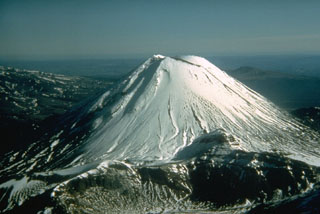Report on Tongariro (New Zealand) — 18 March-24 March 2015
Smithsonian Institution / US Geological Survey
Weekly Volcanic Activity Report, 18 March-24 March 2015
Managing Editor: Sally Sennert.
Please cite this report as:
Global Volcanism Program, 2015. Report on Tongariro (New Zealand) (Sennert, S, ed.). Weekly Volcanic Activity Report, 18 March-24 March 2015. Smithsonian Institution and US Geological Survey.
Tongariro
New Zealand
39.157°S, 175.632°E; summit elev. 1978 m
All times are local (unless otherwise noted)
On 23 March GeoNet reported that during the previous two to three weeks an increase in the number and magnitude of earthquakes at Tongariro was detected by the seismographs around Ngauruhoe. The earthquakes were shallow, with depths less than 5 km. The report noted that although earthquakes are not unusual near Ngauruhoe, it had been some time since significant numbers or events above M 1 were recorded. The Volcanic Alert Level was raised to 1 (on a scale of 0-5).
Geological Summary. Tongariro is a large volcanic massif, located immediately NE of Ruapehu volcano, that is composed of more than a dozen composite cones constructed over a period of 275,000 years. Vents along a NE-trending zone extending from Saddle Cone (below Ruapehu) to Te Maari crater (including vents at the present-day location of Ngauruhoe) were active during several hundred years around 10,000 years ago, producing the largest known eruptions at the Tongariro complex during the Holocene. North Crater stratovolcano is truncated by a broad, shallow crater filled by a solidified lava lake that is cut on the NW side by a small explosion crater. The youngest cone, Ngauruhoe, is also the highest peak.
Source: GeoNet

